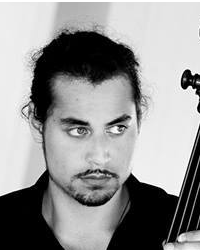Josh
About
- Username
- Josh
- Joined
- Visits
- 255
- Last Active
- Roles
- Member, Moderator
Comments
-
Hi Sadaf, Did you already have a logger item in your sequence? And I'm assuming you're using a form? The response should be logged in a variable with the name that you entered in the response variable box. To log the time, you could place an inline…
-
Hi Ellen, Based on the information you provided there could be multiple things going on. One possibility is that you entered the c in the allowed- and correct response boxes with quotation marks ("). These need to be removed. If that's not the…
-
Hi Tom, what you could do is place an inline_script at the start of your experiment and in it define a variable exp.time_scale = 1. For all the objects where you set a duration, insert e.g. =500*[time_scale] instead of just 500. Now you can alter th…
-
Hi, you could use a sketchpad item with a duration of 10000ms, followed by a keyboard response item that has "return" as allowed response. Alternatively, you could have a keyboard item with a timeout of 10000ms - but all of this depends on…
-
Hi, I'm afraid I don't completely understand your problem. What do you want to do with the enter key and 10 seconds? Cheers Josh
-
Hi, I'm not near my computer at the moment so I cannot verify this, but did you try to change the variable name to see if it works? And could it be the case that your practice loop is also called "practice"? Giving the same name to multipl…
-
Hi, Yes, you can log anything you want manually, with the exp.pygaze_eyetracker.log() command. Cheers, Josh
-
Hi, My guess is that it should work. It's a guess because I haven't tried this specific model, but I'm assuming that the hardware connections (and thus interaction between eyetracker and opensesame) are consistent across models. Cheers Josh
-
Hey, the simplest way to do this would be to just place a second sketchpad behind the first one. Leave the second sketchpad empty and give it a duration of 500 ms. Cheers Josh
-
Hi Chiara, 1) If you use a sketchpad for your visual stimulus, the easiest solution is to place a copy of this sketchpad right after the response collection item. The first sketchpad should have a duration of 0 ms, the response item should have a t…
-
@sebastiaan I just tried to work out this problem with Thomas, but there seems to be a more serious bug underlying this. Since the canvas.text() command doesn't come with a size argument, one has to set the font size manually, for example with canv…
-
Hi Joff, is your pool folder in the same directory as your experiment? (This is needed in order for OpenSesame to recognize files in the pool folder). Cheers Josh
-
And you didn't copy the error message completely. Based on the continuation of that error message we would know what the value of font_size was. Could have been a list as well.. Cheers
-
Hi Thomas, Apparently, one of your font_size values is not a numerical value. Best check your list carefully; maybe there's a value here with a comma instead of a point? (e.g. 13,5 instead of 13.5) Cheers Josh
-
Hi Céline, When did you last run your experiment without any problems? Did anything change since then? Based on the current information I cannot deduce what's causing your problem. Cheers, Joshua
-
Hi Boris, You can do something like your example (although condition == 1 would need to have only one equals-sign! --> condition = 1), but you'd be kind of doing things double. If the condition variable has the exact same value as the subjects v…
-
No problem! Josh
-
Hi Diego, You should consider the time logged by the buttonbox as the accurate one. It is not weird that your tt computation is a bit off: the variable t2 is created slightly after the response collection, and t1 is created slightly before the star…
-
Hi, I'm not sure what causes your problem, but it is certainly possible to create a form by means of an inline_script rather than the widgets. This will require a bit of coding however. You'll have to manually program a text bar in which people can…
-
Hi Helen, We're in the process of developing an eye-tracking tutorial, so be sure to check back on the website frequently! For now, you should start trying out a simple set-up where you collect the eye-position and place a dot at that location: …
-
Hi Masoud, Certainly people have already implemented various scales in OpenSesame (e.g. http://forum.cogsci.nl/index.php?p=/discussion/345/solved-likert-scale-trouble) although I'm not sure whether the self-assessment manikin has already been imple…
-
Hi Céline, If you cannot track which stimulus was shown based on condition parameters, you'll have to log it manually. If you use images, then each stimulus might have a name such as 'image1.jpg'. You then need to log the variable that contains thi…
-
Hi Hymavathy, The pool folder should be in the experiment folder, rather than in the same directory as the experiment folder. Let me know if that solves the problem! Cheers Josh
-
Hi Alexander, Well, one possibility is to just select everything in your excel sheet and to copy-paste it into your loop item. Or do you need this to be done automatically with, say, some variance between subjects? Cheers Josh
-
Hi Morgan, my apologies, I should have specified this. If you name your second variable exp.response_time rather than response_time, you should be able to see it in the logfile - that is, if your logger is set to log all variables automatically. Wit…
-
Hi Morgan, you could insert two inline scripts in your trial sequence, one before and one after the form. In the run-phase of the first one, you create the variable start_time = self.time(). In the second one, you create the variable response_time =…
-
Hi Deiniol, Similar questions have been asked on this forum throughout the last few years; see for example this thread http://www.cogsci.nl/forum/index.php?p=/discussion/254/solved-staircase/p1 Let us know if you need more help :) Josh
-
Hi Sarah, You should be able to achieve this with an inline script. There are python modules for this, see for instance this page: http://stackoverflow.com/questions/2846947/get-screenshot-on-windows-with-python I am wondering though; what do you …
-
There is a simple way to find out (run the experiment!) but I'll spill the beans: milliseconds! Josh
-
Hi Charlotte, it should be easy to check if those individual values make sense or not, as you can calculate some time differences manually. Actually, I think the problem is that you're always collecting your keyboard response after the flash canvas…



